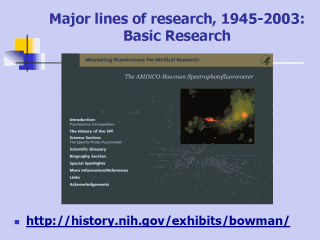 |
NIH has always
emphasized the importance of basic research not related to the solution of
immediate medical problems. National crises such as World War II and the
terror attacks of September 11, 2001, have demonstrated that intense applied
research to solve military problems can best be organized quickly by
continuing to raise the level of basic knowledge during peacetime. Before
the 1970s, much basic research relied on the development of highly
specialized techniques and instruments such as electrophoresis, mass
spectroscopy, and fluorescence spectroscopy. Basic studies funded by NIH
have resulted in the awarding of more than 100 Nobel prizes, five of which
were awarded to intramural scientists. Since the 1970s, techniques have
emerged that allow studies of the human body at the molecular level.
Molecular immunology and molecular neuroscience studies have been
particularly fruitful in recent years. As one example of basic research,
the Office of NIH History developed a website on one instrument, the AMINCO-Bowman
spectrophotofluorometer, which was developed in the intramural program at
NIH and was used in the Nobel prize-winning work of Dr. Julius Axelrod on
neurotransmitters. The URL for this website is
http://history.nih.gov/exhibits/bowman |
